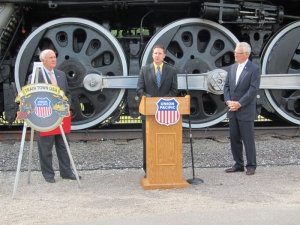Omaha and Union Pacific Railroad share a rich and lengthy history together. Abraham Lincoln created Union Pacific by signing into law the Pacific Railway Act of July 1, 1862. Ground was broken in Omaha in 1863 but actual construction was delayed until July 1865, when the first rail was laid just three months after Lincoln was assassinated. The golden spike marking the completion of the first transcontinental railroad was driven May 10, 1869, at Promontory Summit, Utah, by officials of Union Pacific and Central Pacific. Union Pacific opened the first bridge across the Missouri River between Omaha and Council Bluffs in 1872.
Union Pacific laid its first Omaha tracks in 1865, just a few blocks from where the city’s arena and events center stands today. Since then, Union Pacific employees have lived and worked in the community, establishing deep roots and a prominent place in the nation’s history – all from a city the railroad proudly calls ‘home.’
It started with the signing of the Pacific Railway Act of 1862 by President Abraham Lincoln. The Central Pacific Railroad of California, chartered in 1861, was authorized to build a line east from Sacramento. At the same time, the Act chartered the Union Pacific Railroad Company to build west from the Missouri River. The original legislation granted each railroad 6,400 acres and up to $48,000 in government bonds for each mile completed. And so, The Great Race began.
The Omaha Shops were built in 1863 to support the effort. Master craftsmen from all trades and around the world found work, producing equipment needed to bridge the east and west. Everything from locomotives to freight cars, even the passenger cars’ fine furniture was built with pride in Omaha. If still standing today, the Omaha Shops would neighbor TD Ameritrade Park. A glass monument marks the original site and welcomes guests to the vibrant downtown.
The transcontinental railroad changed America’s landscape. Instead of taking six months to travel coast-to-coast, it could be done in just 10 days. Thanks to telegraph lines along the track, new forms of communication became available. The railroad also connected the United States to the world, carrying goods from Asia and Europe, and giving American entrepreneurs new outlets for agricultural products and more.
Union Pacific’s original freight house dates back to 1891. Nearly 100 years later, it was repurposed into the nation’s first centralized dispatching center. The Harriman Dispatching Center is home to employees who are responsible for train movements across Union Pacific’s 23-state network, dispatching trains much like an air traffic controller. A reinforced concrete bunker houses more than 100 workstations, high definition screens, computerized touch pads and a sound-absorbing “acoustic cloud” ceiling constructed from renewable resources. A telephone pole traveling 175 mph would not be able to penetrate the bunker in a storm.
Union Pacific’s first offices were located in Nebraska’s territorial capital building, and then in Herndon House at 9th and Farnam Street in 1869. In 1911, the railroad moved to its new headquarters at 14th and Dodge Street, where it stayed until 2004. Today, Union Pacific’s headquarters at 14th and Douglas Street is one of the state’s largest office buildings, providing its employees with a view of Omaha in virtually every direction.
